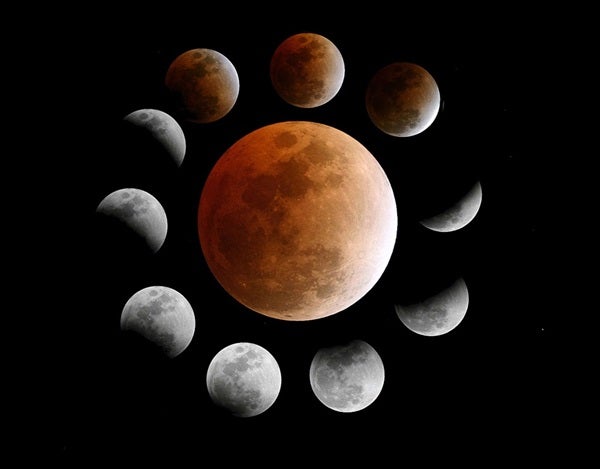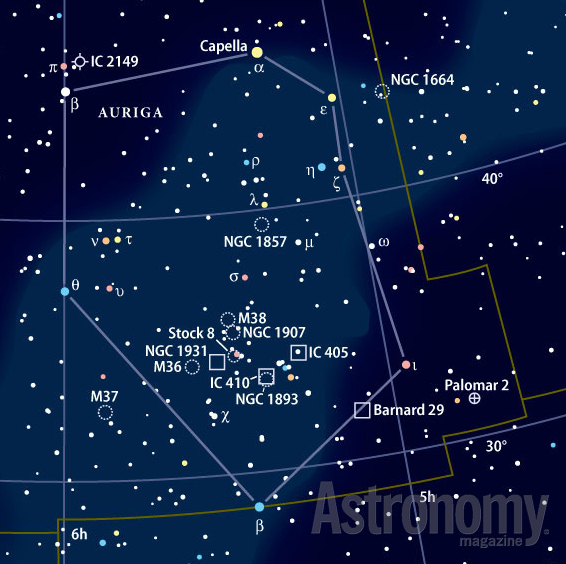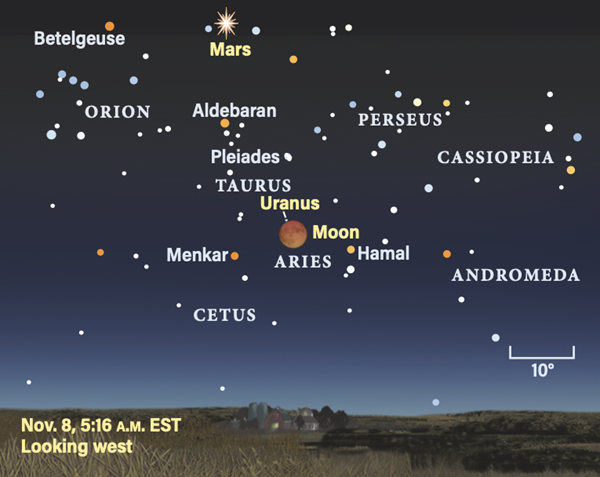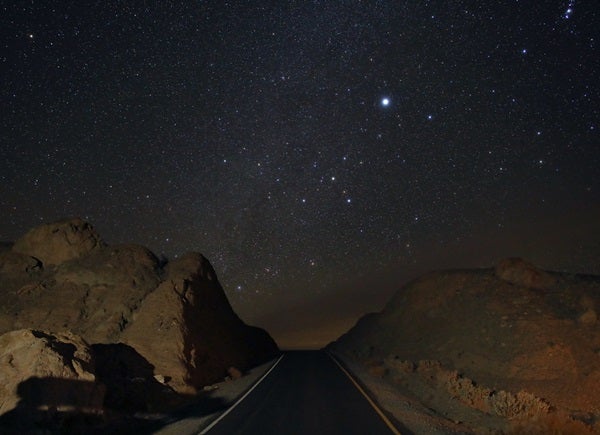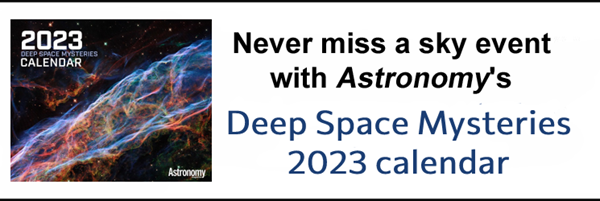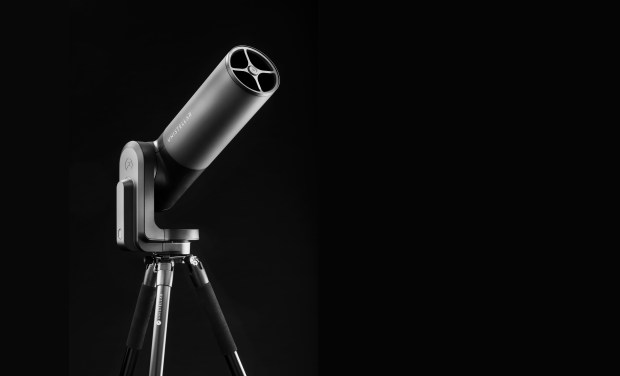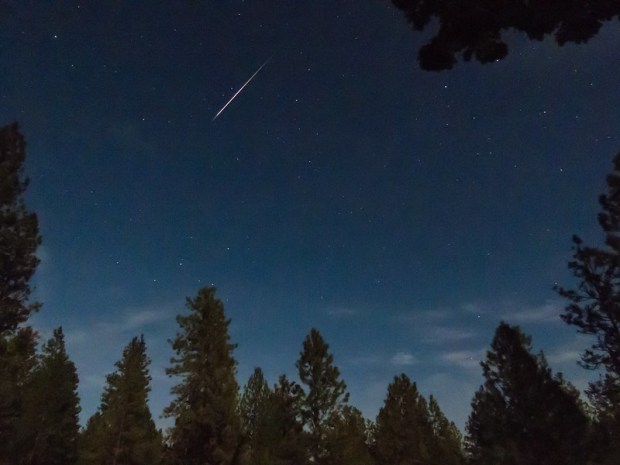Friday, November 4
After passing 3° south of Neptune at 4 A.M. EDT, the Moon slips 2° south of Jupiter at 4 P.M. EDT. Let’s catch the latter pairing this evening.
The Moon is already visible at sunset, hanging low in the east. How soon after darkness begins to fall can you pick out magnitude –2.8 Jupiter, now 3° to our satellite’s upper left (northwest)? The task should be easy by an hour after sunset; the two are nearly 30° high and despite the gibbous Moon, Jupiter’s bright light should be visible to the naked eye.
If you turn a telescope on the giant planet, you may also be able to pick out its four Galilean moons: Ganymede sits to the west, while Callisto (farthest out), Europa, and Io are to the east. The configuration of the last two will depend on when you look, as Io starts the night farther east than Europa, but Europa then passes north of Io over the next few hours. Around 10 P.M. EDT, Europa is less than 10″ due north of Io. From then on out, Io appears closest to Jupiter, with Europa tracking east.
If you do catch the planet early in the evening, you may also see its Great Red Spot. The giant storm appears roughly in the center Jupiter around 6 P.M. EST, then moves west and eventually off the disk within a few hours as the large planet quickly rotates.
Sunrise: 7:33 A.M.
Sunset: 5:54 P.M.
Moonrise: 4:19 P.M.
Moonset: 3:16 A.M.
Moon Phase: Waxing gibbous (85%)
*Times for sunrise, sunset, moonrise, and moonset are given in local time from 40° N 90° W. The Moon’s illumination is given at 12 P.M. local time from the same location.
Saturday, November 5
Cast your eyes toward Auriga the Charioteer a few hours after sunset tonight; within this circular constellation, we’re looking for a star called Almaaz, cataloged as Epsilon (ϵ) Aurigae. Each month, the American Association of Variable Star Observers highlights a different variable star. November’s pick is Almaaz, a 3rd-magnitude sun roughly 3.5° southwest of Auriga’s standout luminary, magnitude 0.1 Capella.
By about 9 P.M. local time, look 25° above the northeastern horizon. You’ll first see bright Capella; glance to its upper right to spot Almaaz. This star is in an eclipsing binary system, which means its companion passes in front of it once every 27 years, blotting out its light for a span of 2 whole years. The last eclipse in this system ended in 2011, so Almaaz is currently at its brightest. But when it is eclipsed, it dips to nearly magnitude 4, closely matching the magnitude of Haedus I, a star 2.8° south of Almaaz. Together with Haedus I and Haedus II (45′ due east of Haedus I), Almaaz forms a thin triangle-shaped asterism known as the Kids. (Although Almaaz is now often included in this asterism, historically, only Haedus I and II were called the Kids.)
Sunrise: 7:34 A.M.
Sunset: 5:53 P.M.
Moonrise: 4:42 P.M.
Moonset: 4:25 A.M.
Moon Phase: Waxing gibbous (92%)
Sunday, November 6
Daylight saving time ends at 2 A.M. this morning; those currently on daylight time will “fall back” one hour.
Because of that change, our targets set early tonight as we chase Boötes the Herdsman, who’s sinking in the west after sunset. We’re first after Xi (ξ) Boötis, a beautifully colored binary about 8.5° east of unmissable magnitude –0.1 Arcturus. Xi’s two components are about 7″ apart, so you’ll want to use higher powers to separate them through a telescope. Once you can see them both, you’ll immediately notice the brighter, 5th-magnitude star appears white, while its dimmer, 7th-magnitude companion glows orangey-red.
If you want an easier pair to split — or a little more time to observe — then opt for Delta (δ) Boötis, which is 19.5° northeast of Arcturus, appearing directly above it in the sky as the constellation sets tonight. This pair can be split through binoculars, as they sit just over 100″ apart. One shines at magnitude 3.5, while the other is a tad brighter than magnitude 9. And these stars, too, appear different colors, with the brighter sun shining yellow and the fainter with a whiter light.
Sunrise: 6:35 A.M.
Sunset: 4:52 P.M.
Moonrise: 4:06 P.M.
Moonset: 4:33 A.M.
Moon Phase: Waxing gibbous (97%)
Monday, November 7
The Big Dipper — the most recognizable portion of Ursa Major the Great Bear — appears right-side up as it swings low under Polaris early this evening. Turn your eye to this large asterism and you’re actually (mostly) looking at a group of stars moving together through space. This bunch, known appropriately as the Ursa Major moving group, is also cataloged as Collinder 285 and contains all but two of the Big Dipper’s stars — only Alkaid, at the tip of the kinked handle, and Dubhe, which marks the upper right corner of the Dipper’s bowl, are not part of the group. And it contains many more stars than just those in the asterism — astronomers have noted at least 60 more that appear to be moving through space in the same way.
While the Big Dipper is right-side up, you’ll notice that the Little Dipper above it, with the North Star at the end of its handle, is upside-down. The two “pour” into each other as they circle throughout the night, pegged in place by Polaris, the star that currently sits above Earth’s North Celestial Pole. Over the next few hours, you can watch as the Big Dipper stars swinging upward to stand on the end of its handle around local midnight; now, the Little Dipper, too, has swung around, and is starting to come right-side up.
Sunrise: 6:36 A.M.
Sunset: 4:51 P.M.
Moonrise: 4:31 P.M.
Moonset: 5:40 A.M.
Moon Phase: Waxing gibbous (99%)
Tuesday, November 8
Today is a busy day! First up, Full Moon occurs at 6:02 A.M. EST. November’s Full Moon is also known as the Beaver Moon. But this Beaver Moon is special, because it’s about to turn red. This morning, there’s a total lunar eclipse lasting 85 minutes. Everyone in the U.S. will see at least part of the eclipse, which will be the last total lunar eclipse visible from the country until March 2025.
The first stage of the eclipse, when the Moon slides into Earth’s lighter, outer shadow, begins just after 3 A.M. EST. The partial eclipse, which is when Luna will start to grow dark, begins just before 4:10 A.M. EST. And totality lasts from 5:16 A.M. to 6:41 A.M. EST, after which the Moon starts moving out of the shadow. The partial eclipse then ends just before 7:50 A.M. EST, and the entire thing concludes shortly before 9 A.M. EST.
The Moon is currently in Aries, close to the location of magnitude 5.7 Uranus. Just as totality begins, Uranus will sit 1.9° east of the Moon’s limb, within the field of view of binoculars or a small telescope. And for observers in some parts of the world — northwestern Canada, Alaska, and eastern Asia — the Moon will pass in front of, or occult, Uranus around the time that the partial phase ends. Our satellite will later pass 0.8° due north of Uranus at 8 A.M. EST.
Rounding out the events today is one you can’t see: Mercury reaches superior conjunction at noon EST. It will reappear in the evening sky by early December.
Sunrise: 6:37 A.M.
Sunset: 4:50 P.M.
Moonrise: 4:59 P.M.
Moonset: 6:46 A.M.
Moon Phase: Full
Wednesday, November 9
Whether or not you saw the Moon occult Uranus last night, the ice giant is again in the spotlight as Uranus reaches opposition at 3 A.M. EST. The second-to-last planet in the solar system is visible all night, so you can opt to observe in the evening after dark or in the morning before sunrise.
Uranus is currently located in Aries; early this morning, the ice giant is 10° directly below (northwest of) the bright Moon. After sunset, the Moon has moved twice as far away, now some 20° east-northeast of the planet.
Although Uranus’ magnitude 5.7 glow might be visible to the sharp-eyed under dark skies, the nearby Moon means it’s definitely a target for binoculars or a telescope tonight. The planet’s disk appears just 4″ across and it forms the tip of a low, squat isosceles triangle with Rho (ρ) and Sigma (σ) Arietis forming the base between them.
For those craving a brighter target, look for magnitude –2.7 Jupiter at nightfall. As darkness grows on the East Coast, Europa is already transiting the planet’s broad disk. The large moon Ganymede follows, slipping onto Jupiter’s face at 7:15 P.M. EST. Forty-five minutes later, the two moons straddle the central meridian, with Europa to the west and Ganymede to the east. It’s quite a picturesque sight. At that time, Io lies in Jupiter’s long, dark shadow to the northeast; it will pop into view just after 8:50 P.M. EST.
But there’s more: Europa’s shadow finally begins to transit at 8:06 P.M. EST, some 30 minutes before the moon itself slides off the disk to the west. From then on, Ganymede leads its fellow moon’s shadow across the cloud tops. Ganymede leaves the disk at 10:03 P.M. EST, and Europa’s shadow finally finishes its trek at 10:35 P.M. EST.
This sequence of events will repeat twice more in November.
Sunrise: 6:38 A.M.
Sunset: 4:49 P.M.
Moonrise: 5:32 P.M.
Moonset: 7:53 A.M.
Moon Phase: Waning gibbous (98%)
Thursday, November 10
Rising in the east at sunset is the V-shaped constellation Taurus. As Earth turns and the sky appears to rotate above us, the Bull is followed by Orion the Hunter. And following him are his two trusty hunting dogs: Canis Minor and Canis Major.
By shortly after midnight, the Big Dog has entirely cleared the horizon, giving you the entire morning before dawn to observe him. This constellation is notably home to the brightest star in the sky, Sirius. And although this famed star deserves all the attention it gets, there is more within the Big Dog to see. Once the celestial canine’s back end has cleared the horizon, look for magnitude 1.8 Wezen (Delta Canis Majoris). Then move 3.5° northeast of this star to land smack dab on 145 Canis Majoris, a binary system often called the Winter Albireo for the resemblance it bears to the two colorful stars that make up the head of Cygnus the Swan.
Train binoculars or a telescope on 145 Cma and you’ll see a 5th-magnitude and 6th-magnitude star. Separated by just under 27″, they’re tight for binoculars, but a clear sky will let you pick up them both. A telescope will split them more easily. The brighter of the two appears golden, while the dimmer looks blue-white. Enjoy their rich, contrasting colors and keep Canis Major in mind; as he grows more prominent in the wintertime sky, we’ll make sure to return for the Big Dog’s other treasures.
Sunrise: 6:39 A.M.
Sunset: 4:48 P.M.
Moonrise: 6:10 P.M.
Moonset: 8:57 A.M.
Moon Phase: Waning gibbous (95%)
Friday, November 11
The Moon passes 2° north of Mars at 9 A.M. EST; catch them together in the early-morning sky, floating high in the west in the constellation Taurus. Two hours before sunrise, they are 55° high and just less than 3° apart, with the Moon slightly northwest of Mars. Both sit between the two horns of the Bull, whose ends are marked by Alheka and Elnath. Below the pair is bright orange Aldebaran, the eye of the Bull, and the loose open cluster called the Hyades. To their lower right, northwest of the Hyades, is the tighter Pleiades cluster, sometimes mistaken for the Little Dipper because its brightest stars form a somewhat cramped spoon shape.
Skipping back to Mars, the Red Planet is nearing its best for the year, a little less than a month from opposition and now appearing 16″ wide through a telescope. Both of its poles are now on view, as its tilt with respect to Earth reached 0° just three days ago. Around local midnight, the prominent features of Olympus Mons and the Tharsis Ridge are visible on the Earth-facing side from the mid-U.S. The planet’s phase is now 96 percent, and it will grow to reach 99 percent before the end of the month.
This is prime Mars observing time, so get in as many sessions as you can!
Sunrise: 6:40 A.M.
Sunset: 4:47 P.M.
Moonrise: 6:55 P.M.
Moonset: 9:58 A.M.
Moon Phase: Waning gibbous (90%)

